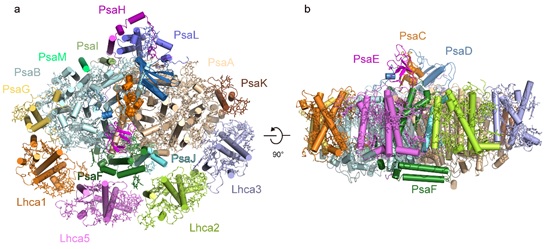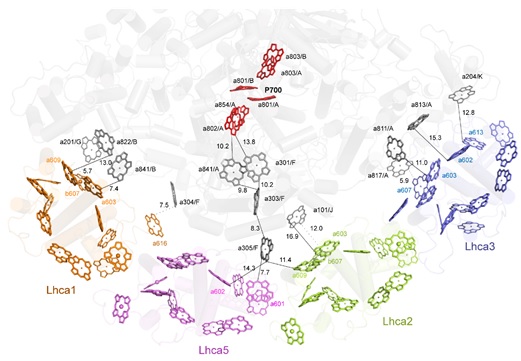Bryophytes (liverworts, mosses, and hornworts) are the first group of plants that shifted from aquatic to terrestrial environments, and thus are among the ancestor of the land plants. Therefore, the organization of photosystem I (PSI)-light harvesting complex I (LHCI) supercomplex of bryophytes is of great interest for understanding the transition of the photosynthetic apparatus from aquatic to terrestrial environments during the evolution of green plants.
Researchers from the Key Laboratory of photobiology, Institute of Botany, Chinese Academy of Sciences purified the PSI-LHCI supercomplex from the moss Physcomitrium patens (P. patens) which is a model plant of bryophytes, and solved its structure at an overall resolution of 3.23  using single-particle cryo-electron microscopy (cryo-EM).
using single-particle cryo-electron microscopy (cryo-EM).
The structure showed that the PSI-LHCI of P. patens (Pp PSI-LHCI) is composed of four light harvesting antenna proteins (Lhca1, Lhca2, Lhca3 and Lhca5), which is the same as the number of LHCIs in the structure of higher plant PSI-LHCI, but Lhca5 in P. patens is replaced by Lhca4 in higher plants. At the junction of Lhca5/Lhca2 and PsaF, a special chlorophyll molecule (Chl 305) is found to be present only in the P. patens PSI-LHCI. This Chl contributes to the efficient energy transfer from Lhca5/Lhca2 to the PSI core.
Compared with the green algae living in water, Pp PSI-LHCI has less light harvesting proteins and reduced light harvesting cross section, whereas it has more efficient energy transfer pathway than that of higher plant PSI-LHCI. This may be related to the low light environment that mosses experience after landing, as reducing light harvesting cross section helps to avoid light damage whereas fast light harvesting helps them to survive.
These results shed light on the mechanisms of light-energy harvesting and transfer in the PSI-LHCI from bryophytes, and provides important clues to the changes that have occurred in PSI-LHCI from aquatic to land plants during evolution.
This finding has been published in Cell Discovery on February 16th, 2021, entitled “Antenna arrangement and energy transfer pathways of PSI-LHCI from the moss Physcomitrella patens”.

Fig. 1 Overall structure of the PSI-LHCI supercomplex from P. patens.

Fig. 2 Plausible energy transfer pathways from LHCI to the PSI core of P. patens.
Article link: https://www.nature.com/articles/s41421-021-00242-9
Contact: Email: Int_office@ibcas.ac.cn
Institute of Botany, Chinese Academy of Sciences
Bryophytes (liverworts, mosses, and hornworts) are the first group of plants that shifted from aquatic to terrestrial environments, and thus are among the ancestor of the land plants. Therefore, the organization of photosystem I (PSI)-light harvesting complex I (LHCI) supercomplex of bryophytes is of great interest for understanding the transition of the photosynthetic apparatus from aquatic to terrestrial environments during the evolution of green plants.
Researchers from the Key Laboratory of photobiology, Institute of Botany, Chinese Academy of Sciences purified the PSI-LHCI supercomplex from the moss Physcomitrium patens (P. patens) which is a model plant of bryophytes, and solved its structure at an overall resolution of 3.23 ![]() using single-particle cryo-electron microscopy (cryo-EM).
using single-particle cryo-electron microscopy (cryo-EM).
The structure showed that the PSI-LHCI of P. patens (Pp PSI-LHCI) is composed of four light harvesting antenna proteins (Lhca1, Lhca2, Lhca3 and Lhca5), which is the same as the number of LHCIs in the structure of higher plant PSI-LHCI, but Lhca5 in P. patens is replaced by Lhca4 in higher plants. At the junction of Lhca5/Lhca2 and PsaF, a special chlorophyll molecule (Chl 305) is found to be present only in the P. patens PSI-LHCI. This Chl contributes to the efficient energy transfer from Lhca5/Lhca2 to the PSI core.
Compared with the green algae living in water, Pp PSI-LHCI has less light harvesting proteins and reduced light harvesting cross section, whereas it has more efficient energy transfer pathway than that of higher plant PSI-LHCI. This may be related to the low light environment that mosses experience after landing, as reducing light harvesting cross section helps to avoid light damage whereas fast light harvesting helps them to survive.
These results shed light on the mechanisms of light-energy harvesting and transfer in the PSI-LHCI from bryophytes, and provides important clues to the changes that have occurred in PSI-LHCI from aquatic to land plants during evolution.
This finding has been published in Cell Discovery on February 16th, 2021, entitled “Antenna arrangement and energy transfer pathways of PSI-LHCI from the moss Physcomitrella patens”.

Fig. 1 Overall structure of the PSI-LHCI supercomplex from P. patens.

Fig. 2 Plausible energy transfer pathways from LHCI to the PSI core of P. patens.
Article link: https://www.nature.com/articles/s41421-021-00242-9
Contact: Email: Int_office@ibcas.ac.cn
Institute of Botany, Chinese Academy of Sciences
